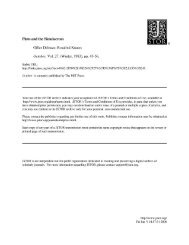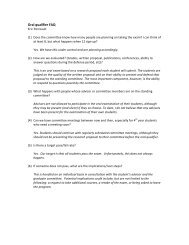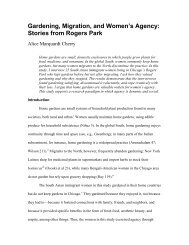research - Associated Student Government, Northwestern University
research - Associated Student Government, Northwestern University
research - Associated Student Government, Northwestern University
Create successful ePaper yourself
Turn your PDF publications into a flip-book with our unique Google optimized e-Paper software.
RESEARCHArticle 10 of the Law on Education of July 10th,1989, establishes a “broad freedom of expression forstudents.” 33 The law of 2003-2004 is seen as an extension,not as a reversal, of this freedom of expression.“Religious symbols are not prohibited per se but can beif they are of a character or ostentatious protest.” 34 TheFrench government wishes to limit the religious contentinside schools so as not to impose on anybody else.At the same time that religion is not to be imposedon students, the school serves as a place to birth Frenchcitizens, a place to inoculate them with republican values.“The first republican values training is and mustremain in school.” 35 “As the school’s founding principle,secularism is a major theme of civic education.” 36 “Theinsistence on schools as religion-free zones goes to theheart of the French idea of citizenship.” 37 “The State defendsthe common values of society which it is derived.Buoyed by a strong vision of citizenship that transcendscommunity affiliations, religious, or ethnic, secularstate creates obligations towards citizens.” 38 Again, thisis deeply related to the idea of integration through thesecular school, as discussed in more detail below.Sub-Frame: Being “French First”A French person, regardless of his or her otheridentities, is expected to be “French first.” “Citizenshipin France has been based on the Republic recognizingindividuals rather than groups. A French citizen owesallegiance to the nation, and has no officially sanctionedethnic or religious identity.” 39 Historically, the Frenchhave gone through great lengths to get the public to seeitself as French. “Although it can be carried to extremes- such as colonial subjects being taught that their ancestorswere Gauls - this view of citizenship is fundamentallynon-discriminatory and inclusive.” 40The Stasi Commission locates and urges to phaseout programs that go against French-ification, for exampleELCO (“un enseignement des langues et culturesd’origine,” teaching of languages and cultures of origin).In the 1970s, France signed bilateral agreements withAlgeria, Spain, Italy, Morocco, Portugal, Serbia-Montenegro,Tunisia and Turkey to teach immigrant childrenthe language and culture of their homelands “at a timewhen the arrival of immigrants was seen as temporary.” 41These contracts were renewed over time but the StasiCommission no longer feels that they are necessary sinceeven the teachers of these programs are “often of Frenchnationality and are destined to live in France permanently.”42 “The Committee notes that against the backgroundof the right to difference, we have moved to the duty ofbelonging.” 43 The ELCO program not only prevents immigrantsfrom being “French first” (or identifying withFrench national identity) and disrupts the “duty of belonging,”it completely prevents integration. “This deviceis often at odds with the integration of immigrant youth[and] promotion of the French language.” 44VOLUME 7, 2011-2012Sub-Frame: Immigrant IntegrationThe secular school is seen as a good place to integrateimmigrants. By keeping things religion-free, immigrantsare asked to embrace the French way of life.To the Stasi Commission, the compromise between thestate and religion seems to be an appropriate milieu foralso pursuing a “more proactive policy of integration.” 45Being French first and exhibiting the French identityis a way to integrate immigrants, thus the governmentreasons that French national identity can help with theintegration process.According to Akan, there are “two fundamental institutionsfor the integration of immigrants in France,namely, school and employment.” 46 “Adapting to Frenchways was in part an economic necessity, since laboroften stipulated that workers dress in a certain way.” 47The Stasi Commission seems to agree with all of theseopinions. In reference to the Labor Code and its prohibitionof discrimination, the Commission writes, “thejudicial court, while recognizing the rights afforded therespect for freedom of conscience, [should also] ensurethat such requirements are compatible with the properperformance of contract work.” 48 Again, the Frenchgovernment sees itself as negotiating a compromise betweencompeting claims: the freedom of conscience andprohibition of discrimination on the one hand, withthe neutrality required by public service or the place ofemployment. In reconciling these individual freedomswith French duties, the French government is hoping tomake integration into French society smoother.The Stasi Commission recognizes the role of theFrench government both in helping to integrate immigrantsin the future and in failing to integrate immigrantsin the past. The Commission concludes thatthe current situation is “a real failure of integrationpolicy of the last twenty years,” through programs suchas ELCO for example. 49 The French government is alsoresponsible for other, more indirect failures of integration,such as the fact that minorities tend to live in deprivedurban areas. 50Sub-Frame: Equality Between the Sexes and Women’sRightsBeing against the equality of women is seen as beingun-French. “Today, secularism can not be conceivedwithout direct link with the principle of equality betweenthe sexes.” 51 It is a part of French-ification. Thefact that women can walk around in traditional Muslimgarb is seen as a failure of the French government.“Basic rights of women are now being violated daily inour country. Such a situation is unacceptable.” 52 Whilethe Stasi Commission does recognize that some “girlsand women wear the veil voluntarily, but others areunder duress or pressure,” their focus is on the latter. 53The French government feels called “to rescue manyyoung girls and women of immigrant origin living inNORTHWESTERN UNDERGRADUATE RESEARCH JOURNAL55











